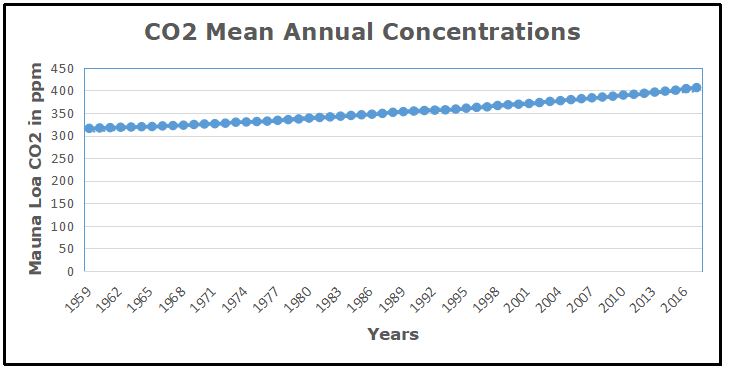This video accompanied an editorial at Investor’s Business Daily Climate Hoax: Global CO2 Emissions Spike, Despite Paris Climate Pledges. Excerpts in italics with my bolds.
Climate Change: Three years after leaders from around the world signed on to the Paris climate agreement, pledging to cut their carbon footprints, global CO2 emissions accelerated. Does anyone still think President Donald Trump was wrong for pulling the U.S. out of this sham agreement?
According to the Global Carbon Project, which monitors this, global CO2 emissions climbed by 1.6% last year. They are on track to shoot up by 2.7% this year. That’s after three years of annual emissions remaining flat.
Worse After Paris Deal
Wait a minute. The accelerating growth in carbon emissions came after some 200 countries signed the Paris agreement?
At the time, Barack Obama called the Paris agreement “an enduring agreement that reduces global carbon pollution and sets the world on a course to a low-carbon future. ”
It “sends a powerful signal that the world is firmly committed to a low-carbon future,” Obama said. He even called the agreement “a turning point for the world.”

Annual CO2 measured at Mauna Loa through 2017.
Right.
The reality is that nations need energy to grow. And the best and most economical forms of energy are oil, natural gas and coal.
CO2 ppm added in the last three years.
(60-year rate 1.53ppm)
2015 2.18ppm
2016 3.38ppm
2017 2.32ppm
So, while all those leaders were making promises and bragging about how they were saving the planet, their economies were increasing the use of fossil fuels.
As the New York Times laments in its front-page story, “Even as coal has fallen out of favor in some markets, the rise in emissions has been driven by stronger demand for natural gas and oil, scientists said. And even as the use of renewable energy like solar and wind power has expanded exponentially, it has not been enough to offset the increased use of fossil fuels.”
China Builds Coal Plants
China — already the single largest contributor of CO2 emissions — will see emissions climb by 4.7%. It continues to build coal-fired plants within its borders, as well as in sub-Saharan Africa, the Times notes.
India’s emissions will likely shoot up by more than 6% this year, as the country tries to do things like bring electricity to 300 million people — almost equal to the entire population of the U.S. — who don’t have it.
As we noted in this space recently, not one of the G20 countries is close to meeting the CO2 emissions targets they pledged to reach in the Paris deal.
This is all further evidence that whatever these leaders claim, and no matter how many end-of-the-world predictions environmentalists make, nobody is serious about drastically cutting CO2 emissions by anywhere near the levels climate scientists say is needed to prevent “global catastrophe.”
Witness the retreat this week by climate-change champion and French President Emmanuel Macron, who suspended the country’s relatively modest carbon tax plan — which would have raised gas prices by 12 cents a gallon — after violent protests broke out across the country.
Or look at liberal Washington state, whose voters overwhelmingly rejected a carbon tax in the midterm elections.
Or look at any poll that measures public priorities and see how low climate change ranks. The latest IBD/TIPP poll found that only 17% ranked dealing with climate change as a top priority for the new Congress.
The Wrong Approach
We’re not complaining about this, mind you. We think all the doom-and-gloom scenarios are wild speculations based on dubious 100-year computer forecasts. And the environmentalist agenda has less to do with saving the planet and more to do with controlling everyone’s lives.
Even if the climate does warm as predicted, the better approach is to adapt to changing environments, if and when they occur. Not wreck entire economies in a futile attempt to stop it.
If nothing else, mankind has proved its remarkable ability to survive and thrive in the harshest environments on Earth.
The sooner world leaders come realize this, the better.
See also UN “Stretches” CO2 Goals

The blue line is CO2 in ppm observed at Mauna Loa. The linear regression line shows the continuation of the 1.53 ppm per year rate projected to the end of this century. As noted above the blue line is already exceeding the earlier rate. The orange line shows CO2 hitting 430 ppm in 2032 at the 1.53 rate, or earlier if more recent rates continue. For example, if the 2.14 ppm per year rate continues, 430 ppm is reached by 2028. The red 450 scenario is reached in 2045. Both scenarios presume zero additional CO2 after those dates.

Reblogged this on Climate Collections.
LikeLike